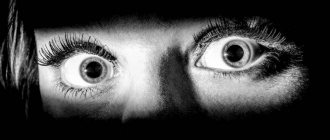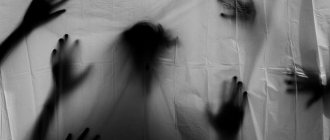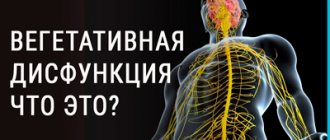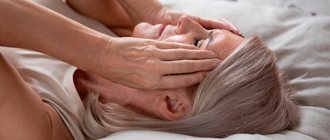To the main symptoms of panic attacks (F41, ICD-10) refers to repeated attacks of severe anxiety, unpredictable in nature, independent of the situation or circumstances. As a rule, an attack of panic attack is accompanied by rapid heartbeat and chest pain, up to the fear of dying from cardiac arrest, a feeling of lack of air, nausea, states of depersonalization and derealization, fear of losing control over oneself and going crazy.
It is important to distinguish between the signs of panic attacks and attacks of normal anxiety. Anxiety is a negatively colored emotion, a premonition that is uncertain regarding the nature of expected events. The causes of anxiety, unlike specific fears, are not objective. In other words, anxiety helps to avoid potentially unwanted situations and their consequences. It becomes the cause of actions that determine a favorable vector of events in an alarming situation.
As for a panic attack, it is a sudden, causeless attack of pronounced anxiety, accompanied by fear and various somatic symptoms. In other words, the clinical signs of panic attacks must necessarily be accompanied by a type of anxiety in which it is impossible to establish the cause of the fear. The nature of such anxiety cannot be explained by the person himself, even at its peak, except as fear for his own life and sanity.
Symptoms and signs of panic attacks
In the clinical picture of the disease, the leading symptoms and signs of panic attacks are strong fear that cannot be rationalized, disturbances in the functioning of the respiratory organs and cardiovascular system, and other phenomena of a vegetative nature. As a rule, the attack occurs instantly and lasts about 15–30 minutes.
The incidence of panic attacks varies from moderate (F41.00, ICD-10) to severe (F40.01, ICD-10). Moderate episodic paroxysmal anxiety corresponds to - from 4 attacks over a distance of 28 days; severe - at least 4 attacks in 7 days at a distance per month.
As a rule, the individual picture of an attack includes the following symptoms and signs of panic attacks:
- cardiopalmus;
- chest discomfort;
- tingling in the heart area;
- rise in blood pressure;
- feeling of lack of air;
- labored breathing;
- dizziness;
- sweating;
- “waves” of heat and cold;
- nausea;
- diarrhea (sometimes).
Objectively, during an attack, those around you can record a change in the color of the skin, sweating, a rise in blood pressure, a high pulse rate, difficulties with coordination of movements, and tremors. However, both the person himself and the people around him usually mistake the symptoms of panic attacks for signs of a heart attack or stroke (especially at the onset - the first attack of PA).
In some cases, with a weak mental constitution (low threshold of resistance to stress factors), a severe panic attack can lead to loss of consciousness. With repeated attacks of PA, anticipatory anxiety develops quite quickly, expanding the range of negative experiences with the fear of expecting an attack. In addition, agoraphobia and restrictive behavior may appear in the clinical picture.
Rice. 1. The mechanism of a panic attack.
Symptoms of panic attacks in women
Clinical practice shows that women are more susceptible to episodic paroxysmal anxiety than men. The symptoms of panic attacks in women are not much different from the signs of the “male” version of the disease. However, they still affect the health and adjust the life of an adult woman.
The main symptoms of panic attacks in women include:
- menstrual irregularities;
- other endocrine disorders affecting reproductive function;
- increased risk of developing neurotic and depressive disorders;
- alcoholism according to the female type.
In addition, the development of the disease can cause disruption in a woman’s functioning in the family, even leading to the risk of divorce proceedings. Indirectly, the disease inevitably affects both men and children, becoming the cause of “secondary” psychopathology, including developmental disorders of the mental apparatus in children.
Symptoms of panic attacks in men
Symptoms of panic attacks in men can radically change a person’s life, masking the disease under character traits, lifestyle, or unusual creeds. Outside of marriage, it is quite difficult for such a person to maintain a relationship; in marriage - to preserve the family or relationships in it, to create favorable conditions for raising children, the healthy development of their mental apparatus.
Typical symptoms of panic attacks in men that affect quality of life include:
- problems with potency;
- risk of developing severe depression with suicidal tendencies;
- rapid alcoholization, interest in surfactants.
If the picture of the disease is dominated by depressive tendencies, alcoholism or addiction to psychoactive substances quickly develops, and there is a high risk of suicidal tendencies. Most successful attempts to commit suicide during the course of the disease are observed in men.
Symptoms of panic attacks in teenagers and children
As a rule, severe symptoms of panic attacks in adolescents can be detected between the ages of 7-10 years. First of all, they manifest themselves in an unusual deterioration in the well-being of children, a decrease in mood and activity. Within an educational institution, such a child may become a victim of bullying or violence from classmates, fall behind in academic performance, and withdraw into himself.
Symptoms of panic attacks in adolescents that occur against a background of increased anxiety or fear attacks include:
- decreased tone;
- fast fatiguability;
- frequent headaches;
- gastrointestinal disorders;
- increased sweating;
- cardiopalmus;
- pain in the heart area;
- dyspnea.
Unfortunately, symptoms of panic attacks in children are not detected in a timely manner. Parents can search for a long time for the true reason for the deterioration of their child’s well-being, visiting doctors of various specializations year after year, ignoring treatment for panic attacks by a child psychiatrist or neuropsychiatrist. However, having learned to cope with attacks of PA, such a child becomes “adapted” only externally, maintaining psychopathology in potency. Having entered adulthood, such children have a high probability of relapse of the disease and, consequently, its development.
Rice. 2. Types of reaction to stress and panic attack.
Clinical manifestations of PA syndrome
In neurological and neurosurgical practice, vertebral artery syndrome is most often caused by cervical osteochondrosis. Symptoms at the stage of functional disorders can be presented:
- dizziness, pain in one half of the head, irradiation of cephalalgia from the back of the head to the forehead (like removing a helmet), there is a connection between the intensity of manifestations and movements in the cervical region
- clinic of destructive-dystrophic disease of the spine - spasm of the neck muscles, sound phenomena (crunching, clicking), paresthesia of the skin in the occipital region, pain in the shoulders, arms
- narrowing of the field of vision, flickering of flies, flashes, pain in the eyeball, redness of the eyelids, etc.
- unsteadiness of gait, incoordination of movements, tinnitus, impaired perception of whispered speech
- vegetative manifestations - sweating, diffuse sensation of heat or cold, increased heart rate, instability of blood pressure
The development of the organic stage is indicated by transient ischemic attacks.
Types of attacks with panic attacks
Panic attacks are individual in nature. They differ in the symptoms and conditions that predominate in the clinical picture. Conventionally, attacks are divided into six types, unfolding as the disease progresses (from symptomatic poor attacks to extensive phobic avoidance with secondary depression):
- typical - autonomic disorders and undifferentiated phobias predominate;
- phobic - the picture of autonomic disorders is dominated by subjective fears that arise in situations that are dangerous only in the opinion of the person suffering from PA;
- affective - strong depressive tendencies, painfully low mood, negative irritability are observed;
- senestopathic - unpleasant and frightening somatic sensations of an unknown nature are emphasized (the person cannot specifically describe the painful condition);
- hyperventilation - there are pronounced breathing disorders (rapid and/or deep breathing, attacks of apnea, paresthesia and muscle pain);
- conversion - tendencies of a hysterical nature, senestopathic reactions dominate, panic is expressed insignificantly or is absent altogether;
- depersonalization-derelization - feelings of unreality of the world around us and a person’s perception of himself come to the fore.
Nocturnal panic attacks are different from nightmares and are not associated with images that appear in dreams in the second half of the night, in the REM phase - these are the dreams that a person remembers. Their occurrence is usually observed in the first half of the night, from 12 to 4 am. Similar to the “daytime” version, panic attacks at night are characterized by a sudden attack of severe fear for life (fear of respiratory arrest, heart failure) or unbearable anxiety.
Why does an attack develop?
Many scientific works and studies have been devoted to the syndrome, but the exact causes of its occurrence have not yet been determined. There are a number of factors that predispose to panic attacks:
- Female.
- Young age - the first panic attack is recorded on average at 20-30 years.
- Hereditary predisposition. Most patients indicate the presence of anxiety disorders in close relatives.
- Overprotection in childhood and increased anxiety on the part of parents.
- Unfavorable microclimate, frequent conflicts in the family where the patient was raised.
- Characteristic personality traits: low self-esteem, hypersensitivity, catastrophic thinking style. Patients who are faced with the problem of panic attacks often experience difficulties with psychological relaxation and cannot “let go” of anxious thoughts and fully relax.
- Periodically occurring disruption of the blood supply to the brain, causing attacks of fear and dizziness.
Despite the fact that panic attacks occur suddenly, the likelihood of their development increases in the presence of provoking triggers: acute psychotraumatic events (serious illness, death of a loved one, divorce), biological causes (hormonal changes), physical factors (increased physical activity, acclimatization, etc.) .).
Risk factors for developing symptoms and signs of PA
There are risk factors that precede the onset of panic attacks. These include the mental constitution of a person with an emphasis on general negative affectivity - with a tendency to “get stuck” on negative emotions, to give a negative assessment to almost everything that happens in life. Childhood, the nature of the relationship between parents, and parenting style play an important role in the formation of such an outlook on life.
“Genetic” factor and symptoms of PA
The occurrence of symptoms of panic attacks is influenced by growing up in an unfavorable family environment, where the child witnesses quarrels and violent conflicts between parents. Psychological and physical abuse in childhood, including sexual abuse, is also a risk factor for developing signs of panic attacks. This also includes such strong stress factors as parental abandonment of the child, deprivation of parental rights, and their premature death.
The emotional deprivation of a child with a significant person (son - mother, daughter - father), who provides a sense of security, is the cause of dissonance between sensory and emotional experience. A sure sign of such a situation in the family is overprotection, which cannot replace love for the child. Growing up in such a family creates the preconditions for the development of symptoms of panic attacks due, for example, to the repression of an anxious state, including the fear of being abandoned and, consequently, of dying, and the lack of understanding of its (fear) true causes (unconscious constant anxiety is the norm for such a person).
Clinical statistics also point to a “genetic” factor in the appearance of signs of panic attacks . For example, in children whose mothers suffered from PA, the risk of developing the disease increases significantly. It should be understood that the genetic factor here means not only the possibility of transmitting psychopathology by inheritance, but also its acquisition as a child copying an “anxious response”, or a combination of both. In particular, if parents suffer from mood disorders (eg, anxiety, depression, bipolar disorder), there is also a possibility of symptoms and signs of panic attacks in the child.
“Social” factor and signs of PA
Among the risk factors that provoke the development of symptoms of panic attacks in adulthood are lifestyle and traumatic events that negatively affect a person’s mental health:
- active smoking;
- alcohol abuse;
- drug use;
- side effects of medications;
- surgical intervention under general anesthesia;
- life in constant stress;
- interpersonal, family conflicts;
- divorce, other difficult life situations;
- chronic somatic diseases;
- stay in a military conflict zone;
- road accident;
- being in the zone of man-made and natural disasters;
- death of a loved one.
Among the somatic diseases, the presence of which potentiates the risk of symptoms of panic attacks, it should be noted bronchial asthma, chronic bronchitis, chronic obstructive pulmonary disease, arrhythmia, angina pectoris, hypertension, mitral valve prolapse, hypo- and hyperthyroidism, epilepsy, somatoform disorders, OCD, PTSD .
Types of vertebral artery syndrome
The vertebral artery, most of it, together with the autonomic plexus and veins passes in the vertebral canal. The diameter of the latter in the cervical spine is smaller compared to the lumen in the thoracic and lumbar segments, so the likelihood of compression/irritation of the neurovascular bundle tightly adjacent to the bone structures is higher. Degenerative-dystrophic changes in the vertebrae - proliferation of osteophytes, formation of pathological joints with uncovertebral arthrosis, excessive mobility of the vertebrae, subluxation - further contribute to a decrease in diameter, lead to constant irritation of the sympathetic plexus or compression of the vertebral arteries/arteries (compression-irritative version of the VA syndrome).
If vasospasm is a consequence of irritation of the afferent structures of the spinal nerve, they speak of a reflex-angiospastic form: pathological impulses cause disruption of the centers that control blood pressure and vascular tone not only of the head, but also of the heart.
List of used literature
1. ROP. "Panic disorder."
2. ROP. "Panic disorder in adults."
3. Francesetti D. “Gestalt therapy in the unity of clinical and social contexts.”
4. Natolochnaya O., Cherkasov A. “Panic attacks as a syndrome of the 21st century.”
5. Shitov E.A., Shustov D.I. "Neurotic and somatoform disorders."
6. Shapiro E. “The Panic Attack workbook.”
7. Neil A., Bourdeau D., Kitchen K., Joseph-Massiah L. “Anxiety disorders.”
Share
Share
Stages and methods of treatment
Treatment of panic attacks is aimed at stabilizing the patient’s mental state. For this purpose, medications, physical therapy, physiotherapy, and manual therapy are used.
Analgesics, NSAIDs, muscle relaxants, antidepressants, chondroprotectors, etc. are used to treat osteochondrosis with panic attacks.
Therapy can be divided into 3 stages:
- Eliminate pain, relax the muscles that compress the nerve roots, as well as blood vessels. For this purpose, the patient is prescribed analgesics and NSAIDs. Drugs from the first group (Ketoral, Baralgin) help relieve pain. And medications from the second group (Ibuprofen, Diclofenac) relieve inflammation, relieve pain, and restore mobility, which was impaired due to compression of the spinal nerves. Muscle relaxants relieve tension in muscle tissue.
- Restoration of metabolic processes. Patients are prescribed Vinpocetine, Vasobral, which activate blood circulation and improve metabolic processes. Drugs from the group of chondroprotectors (Chondroitin, Rumalon) affect the metabolism in intervertebral discs, stimulate their regeneration, and slow down destruction. Vitamin and mineral complexes strengthen the immune system and speed up metabolism. Antidepressants (Afobazol, Bellaspon) help fight depression and relieve anxiety attacks. Neuroprotectors protect nerve cells from pathogenic factors.
- Prevention of relapses and strengthening of tissues. To get rid of the causes that provoke panic crises, you need to undergo treatment with a psychologist. For this purpose, methods such as meditation and auto-training are used. It is recommended to avoid excessive stress on the cervical spine, walk more often, swim, and periodically stand up and stretch the cervical collar area when working at the computer.
No ads 3
Reference. In case of autonomic dysfunction, it is recommended to visit a psychotherapist if the pathology is caused by neurotic disorders.
Complex therapy includes physiotherapy. To do this, the damaged area of the cervical spine is exposed to a magnetic field, ultrasound, laser radiation, and low-frequency currents. To relieve pain, electrophoresis with solutions of magnesia, novocaine, etc. is prescribed. Stone therapy (hot stone massage) and aromatherapy are also indicated. These procedures increase the effectiveness of other therapeutic methods, speed up recovery, and improve overall well-being.
Acupuncture (acupuncture) can help relax tense muscles in the neck. During the procedure, the specialist pierces biologically active points on the damaged area with thin needles.
Classic or cupping massage sessions accelerate blood flow, metabolic processes, tissue trophism, as well as their healing. For cervical osteochondrosis with panic attacks, manual therapy is often prescribed, during which a specialist acts on the cervical segment of the spine with his hands.
Important. Massage, as well as manual therapy, should be carried out by an experienced specialist, since inept actions can aggravate the situation and cause complications (damage to nerve roots, blood vessels).
With the help of physical therapy, the patient can strengthen the muscles in the damaged area, speed up metabolism and blood circulation, restore motor activity of the spine, and improve overall physical and psychological condition. But to get lasting positive results, you need to train daily. The complex for each patient is compiled separately by the attending physician.
The patient must change his lifestyle:
- Adequate sleep of 8 hours per day.
- Moderate physical activity.
- Proper nutrition.
- Maintaining a daily routine.
- Rejection of bad habits.
In addition, it is recommended to wear a Shants collar. This orthopedic device relieves stress from the cervical spine, allows it to relax and correct posture. Wearing a collar is indicated for osteochondrosis of the cervicothoracic region. You need to wear it no longer than 2 – 3 hours a day, otherwise the muscles will weaken.
Treatment can be supplemented with herbal medicines that normalize the activity of the nervous system, stabilize the psycho-emotional state, improve the transmission of nerve impulses, restore metabolic processes, and increase the body’s protective properties. Remedies based on herbal components reduce the duration of panic attacks, improve brain functionality, as well as the general condition of the patient.
Cost of treatment in our clinic
| Service | Price | |
| Ambulatory treatment | ||
| Psychiatrist consultation | 4 500 ₽ | |
| Consultation with a psychotherapist | 4 500 ₽ | |
| Psychodiagnostics extended | 7 000 ₽ | |
| Consultation with a psychiatrist at home | 6 000 ₽ | |
| Treatment in hospital | ||
| Delivery to hospital | For free | |
| Standard room | 7 700 ₽ | |
| 3-bed superior room | 10 600 ₽ | |
| 2-bed superior room | 13 700 ₽ | |
| 1 local VIP chamber | 19 000 ₽ | |
| Doctor's appointment 2 weeks after discharge | For free | |








